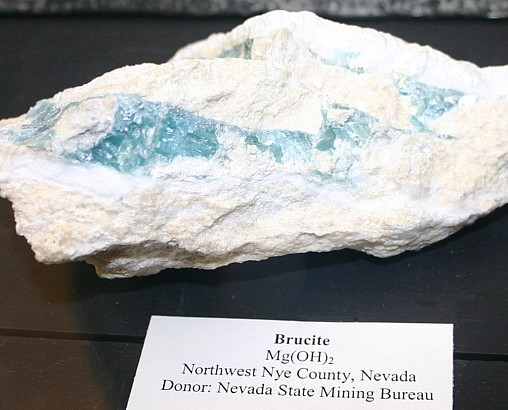|
.
Brucite
Mineral Facts:
Chemical
Formula: Mg(OH)2
Brucite is
the hydroxide of magnesium, though iron and manganese are sometimes present.
It is a white, soft mineral.
Color: white to
gray, Sometimes light blue or
green.
Hardness:
2.5
Density:
2.39
Cleavage:
One perfect basal cleavage on 001.
Crystallography:
Hexagonal-rhombohedral.
Crystals usually tabular
with prominent basal planes, showing at times small rhombohedral
truncations. Commonly occurs in foliated or massive forms.
Luster:.
Luster on base pearly, elsewhere vitreous to waxy,
fibrous varieties silky; translucent to subtranslucent.
|
 |
|
Composition, Structure and
Associated Minerals:
Brucite is found associated with serpentine, dolomite, magnesite, chromite,
etc., as a decomposition product of magnesium silicates. Brucite is usually
associated with other magnesium minerals. It is often found in veins cutting
the rock known as serpentine, where it is probably a weathering product, and
is sometimes found in masses in limestone, especially near its contact with
igneous rocks.
Identification
and Diagnostics
Recognized by its foliated
structure, light color and pearly luster on cleavage face. Distinguished
from talc by its greater hardness and lack of greasy feel. When intensely
heated, it glows. After heating, it reacts alkaline. When moistened with
cobalt nitrate solution and heated, it turns pink, the characteristic
reaction for magnesium. Easily soluble in hydrochloric acid, and after
solution has been made ammoniacal an addition of sodium phosphate gives a
white granular precipitate of ammonium magnesium phosphate (another test for
magnesium). The pure mineral is soluble in acids. Brucite resembles in many
respects
gypsum, talc, diaspore
and some micas. It is distinguished from diaspore and mica by its hardness
and from talc by its solubility in acids. Gypsum is a sulphate, hence the
test for
sulphur or sulfates
will sufficiently characterize it.
Localities
Notable localities for brucite are at Unst, one of the
Shetland Islands, where it occurs in a crystallized form; Aosta, Italy; at
Tilly Foster Iron Mine, Brewster, New York; at Wood's Mine, Texas,
Pennsylvania, and at Fritz Island, near Reading, in the same State.
At Gabbs, in
Northwest Nye County, Nevada, large amounts of brucite occurs in a magnesite
body within a dolomite formation. The brucite occurs near the contact of the
magnesite and a body of altered granodiorite. Considerable magnesite and
brucite have been mined here for their magnesium content.
Industrial Uses of
Brucite
Brucite is an important ore of the metal
Magnesium, and along with magnesite, has been mined in large quantities at
Gabbs, in central Nevada. Magnesium is an important metal in many
lightweight alloys and is extensively used in aircraft construction.
.Return
to the
Mineral Collectors Information Page |
|


